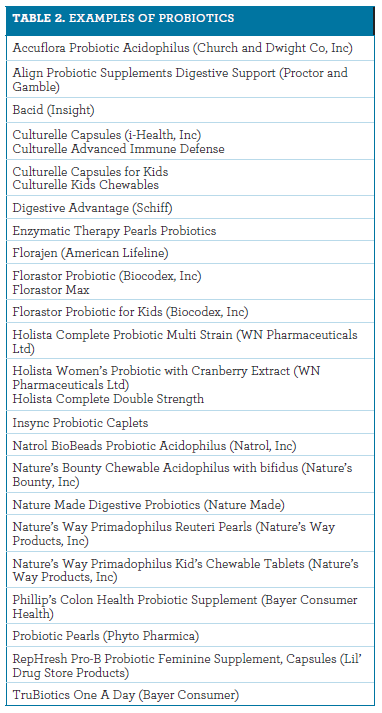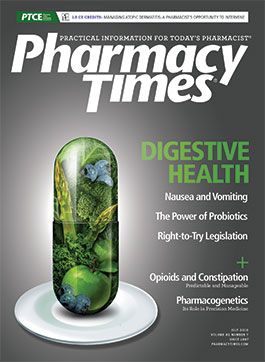Publication
Article
Pharmacy Times
The Power of Probiotics: Exploring the Health Benefits
Author(s):
According to a National Health Interview Survey, probiotics are the third most commonly used dietary supplements.
According to a National Health Interview Survey, probiotics are the third most commonly used dietary supplements, after vitamins and minerals, and the use of probiotic supplements continues to increase annually. In the past few years, the use of probiotic supplements has gained tremendous popularity due to the possible health benefits, and research is revealing more about the beneficial effects of these supermicrobes.
According to the National Institutes of Health National Center for Complementary and Integrative Health and the World Health Organization, probiotics are classified as “live microorganisms that are either the same as or comparable to microorganisms found naturally in the human body, and when ingested in sufficient amounts, may be beneficial to health.”1-5 Probiotics are generally classified based on genus, species, and strain, and studies have investigated various strains of probiotics to determine their health effects.2-7 Although probiotics are frequently used to treat antibiotic-associated diarrhea and to promote digestive health, numerous researchers have postulated that the use of probiotics may be associated with a plethora of health benefits (Table 11-10).1-9

Pharmacists are likely to encounter patients seeking advice about the selection and use of probiotic supplements, and should be prepared to provide patients with pertinent information about proper use.
PROBIOTIC SUPPLEMENTS
Probiotics can be found in a variety of dietary sources, but are universally present in fermented products, such as some dairy products (eg, yogurt, yogurt drinks, buttermilk), juices, soy beverages, sauerkraut, and miso.2 Although these sources are readily available to many people, some consumers elect to use probiotic dietary supplements, which are available in dosage forms such as capsules, tablets, and powders (Table 2). Some formulations are marketed specifically for adults or for pediatric patient populations.

In probiotic foods and dietary supplements, the bacteria may be present already or added during the preparation process.1-7 Formulations of probiotic supplements vary according to the manufacturers and may contain 1 or more of the species of Lactobacillus, Bifidobacterium, and Saccharomyces.7 Within the Lactobacillus strain, Lactobacillus reuteri is the most prevalent strain in the human body; however, available supplements may contain L rhamnosus GG, L reuteri, L acidophilus, L bulgaricus, and L fermentum.3,7 Strains of Bifidobacterium found in supplements may include B longum, B bifidum, B breve, B infanti, or B lactis. Saccharomyces boulardii, which is yeast, is the only one of the Saccharomyces species that is used in dietary supplements.1 Lactobacillus and Saccharomyces products are recommended for antibiotic-associated diarrhea, and L rhamnosus GG is suggested for atopy and dermatitis, although the use of L acidophilus and Bifidobacterium species has shown some benefit, as well.7
COUNSELING TIPS
Before recommending the use of any probiotic supplement, pharmacists should advise patients, especially those with concurrent medical conditions or those taking other medications, to seek advice from their primary health care provider (PHCP) to ascertain appropriateness of use. According to the National Institutes of Health, patients with a compromised immune system should be advised not to use probiotics because of the potential for developing systemic infections, and those with serious medical conditions should be monitored closely for adverse effects (AEs) while taking probiotics.1-7 Women who are pregnant or breast-feeding should always consult their PHCP before using any supplement. Although the data are limited, there are no reports of harmful effects linked with the use of probiotics in late-term pregnancy or in women who have been breast-feeding.1
Patients should be reminded to only use probiotic supplements from reputable companies, and to adhere to the manufacturer’s dosage guidelines and directions for use. Patients should also be reminded that concurrent administration of probiotic supplements and any antibiotics or antifungals is usually not recommended, and dosing intervals of these agents should be at least 2 hours apart.1,7
In general, probiotic supplements are well tolerated; however, they have been associated with some AEs, such as mild episodes of bloating and flatulence, which tend to diminish over time.1-7 The incidence of AEs may be reduced if doses are titrated slowly and taken only in small increments over time.7 Parents electing to give children probiotics should only use pediatric formulations and should monitor their children for diarrhea.1-7 Parents should be encouraged to discuss the use of probiotics in children with their pediatrician to ascertain appropriateness of use. Patients who have concerns about AEs should be encouraged to seek advice from their PHCP.
Ms. Terrie is a clinical pharmacist and medical writer based in Haymarket, Virginia.
References
- Probiotics: in depth. National Center for Complementary and Integrative Health website. nccam.nih.gov/health/probiotics/introduction.htm. Updated July, 2015. Accessed May 23, 2016.
- Rollins C. Baker functional and meal replacement foods. In: Krinsky D, Berardi R, Ferreri S, et al, eds. Handbook of Nonprescription Drugs. 18th ed. Washington, DC: American Pharmacists Association; 2015.
- Williams NT. Probiotics. Am J Health Syst Pharm. 2010;67(6):449-458. doi: 10.2146/ajhp090168.
- Five things to know about probiotics. National Center for Complementary and Integrative Health website. nccih.nih.gov/health/tips/probiotics. Accessed May 23, 2016.
- Najm W, Lie D. Dietary supplements commonly used for prevention. Prim Care. 2008;35(4):749-767. doi: 10.1016/j.pop.2008.07.010.
- Probiotic basics. California Diary Research Foundation website. cdrf.org/home/checkoff-investments/usprobiotics/. Accessed May 23, 2016.
- McQueen C. Nonbotanical natural medicines. In: Krinsky D, Berardi R, Ferreri S, et al, eds. Handbook of Nonprescription Drugs. 18th ed. Washington, DC: American Pharmacists Association; 2015.
- Goldenberg JZ, Ma SS, Saxton JD, et al. Probiotics for the prevention of Clostridium difficile-associated diarrhea in adults and children. Cochrane Database Syst Rev. 2013;5:CD006095. doi: 10.1002/14651858.CD006095.pub3.
- Dwyer JP, Dwyer PL. Lactobacillus probiotics may prevent recurrent UTIs in postmenopausal women. Evid Based Med. 2013;18(4):141-142. doi: 10.1136/eb-2012-100961.
- Dilli D, Aydin B, ZenciroÄŸlu A, Özyazici E, Beken S, OkumuÅŸ N. Treatment outcomes of infants with cyanotic congenital heart disease treated with synbiotics. Pediatrics. 2013;132(4): e932-e938. doi: 10.1542/peds.2013-1262.







